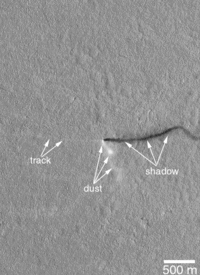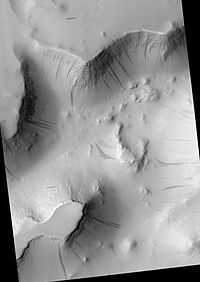Amazonis quadrangle
| Amazonis quadrangle | |
|---|---|
 Map of Amazonis quadrangle from Mars Orbiter Laser Altimeter (MOLA) data. The highest elevations are red and the lowest are blue. | |
| Coordinates | 15°00′N 157°30′W / 15°N 157.5°WCoordinates: 15°00′N 157°30′W / 15°N 157.5°W |

The Amazonis quadrangle is one of a series of 30 quadrangle maps of Mars used by the United States Geological Survey (USGS) Astrogeology Research Program. The Amazonis quadrangle is also referred to as MC-8 (Mars Chart-8).[1]
The quadrangle covers the area from 135° to 180° west longitude and 0° to 30° north latitude on Mars. This area is considered to be among the youngest parts of Mars because it has a very low density of craters. The Amazonia period is named after this area. This quadrangle contains special, unusual features called the Medusae Fossae Formation and Sulci.
Medusae Fossae Formation
The Amazonis quadrangle is of special interest to scientists because it contains a big part of a formation, called the Medusae Fossae Formation. It is a soft, easily eroded deposit that extends for nearly 1,000 km along the equator of Mars. The surface of the formation has been eroded by the wind into a series of linear ridges called yardangs. These ridges generally point in direction of the prevailing winds that carved them and demonstrate the erosive power of Martian winds. The easily eroded nature of the Medusae Fossae Formation suggests that it is composed of weakly cemented particles,[2] and was most likely formed by the deposition of wind-blown dust or volcanic ash. Using a global climate model, a group of researchers headed by Laura Kerber found that the Medusae Fossae Formation could have easily been formed from ash from the volcanoes Apollinaris Mons, Arsia Mons, and possibly Pavonis Mons.[3] Another evidence for a fine-grained composition is that the area gives almost no radar return. For this reason it has been called a "stealth" region.[4] Layers are seen in parts of the formation. Images from spacecraft show that they have different degrees of hardness probably because of significant variations in the physical properties, composition, particle size, and/or cementation. Very few impact craters are visible throughout the area so the surface is relatively young.[5]
Images
-
Map of Amazonis quadrangle.
-
Medusae Fossae Formation and its location relative to Olympus Mons, as seen by THEMIS.
-

Plateau made up of Medusae Fossae materials and rootless cones, as seen by HiRISE.
-

Yardangs in the Medusae Fossae formation, as seen by HiRISE under HiWish program.
-

Martian Dust Devil - in Amazonis Planitia (April 10, 2001) (also) (video (02:19)).
Sulci
A very rugged terrain extends from the base of Olympus Mons. It is called Lycus Sulci. Sulci is a Latin term that refers to the furrows on the surface of a brain, so Lycus Sulci has many furrows or grooves. The furrows are huge—up to a full kilometer deep.[6] It would be extremely difficult to walk across it or to land a space ship there. A picture of this area is shown below.
-
Sulci in Amazonis, as seen by THEMIS. "Sulci" in Mars geography language means a furrow, like a furrow on a brain's surface. This Sulci came from the basal scarp of Olympus Mons
-
Lycus Sulci, as seen by HiRISE. Click on image for a better view of Dark Slope Streaks.
Columnar Jointing
Lava flows sometimes cool to form large groups of more-or-less equally sized columns. The resolution of the HiRISE images is such that the columns were found in various locations in 2009.
-

Columnar jointing in a crater in Marte Vallis.
-
Columnar jointing on the Earth.
-

Columnar jointing on the Earth.
-
Columnar Jointing in Yellowstone National Park.
Craters
Impact craters generally have a rim with ejecta around them, in contrast volcanic craters usually do not have a rim or ejecta deposits. As craters get larger (greater than 10 km in diameter) they usually have a central peak.[7] The peak is caused by a rebound of the crater floor following the impact.[8] Sometimes craters will display layers. Since the collision that produces a crater is like a powerful explosion, rocks from deep underground are tossed onto the surface. Hence, craters can show us what lies deep under the surface.
A pedestal crater is a crater with its ejecta sitting above the surrounding terrain and thereby forming a raised platform. They form when an impact crater ejects material which forms an erosion resistant layer, thus protecting the immediate area from erosion. As a result of this hard covering, the crater and its ejecta become elevated, as erosion removes the softer material beyond the ejecta. Some pedestals have been accurately measured to be hundreds of meters above the surrounding area. This means that hundreds of meters of material were eroded away. Pedestal craters were first observed during the Mariner missions.[9][10][11]
Research published in the journal Icarus has found pits in Tooting Crater that are caused by hot ejecta falling on ground containing ice. The pits are formed by heat forming steam that rushes out from groups of pits simultaneously, thereby blowing away from the pit ejecta.[12] [13]
-

Pedestal crater in Amazonis with Dark Slope Streaks, as seen by HiRISE.
-

Pedestal craters form when the ejecta from impacts protect the underlying material from erosion. As a result of this process, craters appear perched above their surroundings.
-

Drawing shows a later idea of how some pedestal craters form. In this way of thinking, an impacting projectile goes into an ice-rich layer--but no further. Heat and wind from the impact hardens the surface against erosion. This hardening can be accomplished by the melting of ice which produces a salt/mineral solution thereby cementing the surface.
-
Wall of Tooting Crater, as seen by HiRISE
-
Pettit Crater rim, as seen by HiRISE
-
Nicholson mound with dark streaks, as seen by HiRISE
Other pictures from the Amazonis quadrangle
-
Tartarus Colles channel, as seen by HiRISE. Scale bar is 500 meters. Click on image to see bridge across channel.
-
Olympus Mons scarp, as seen by HiRISE. Scale bar is 500 meters long.
-
Channels From Fissure, as seen by HiRISE. The fissure probably started the water flowing to make the channel. The channels look somewhat better in the enlarged view of the original image.
-
Streamlined Island in Marte Vallis, as seen by HiRISE. Click on image for good view of Dark Slope Streaks. Island is just to the west of Pettit Crater. Scale bar is 500 meters long.
-

Possible inverted stream channels in Phlegra Dorsa region, as seen by HiRISE under HiWish program. The ridges were probably once stream valleys that have become full of sediment and cemented. So, they became hardened against erosion which removed surrounding material.
-

Narrow ridges, as seen by HiRISE under HiWish program. The ridges may be caused by dikes or by some other mechanism.
-

Surfaces in Amazonis quadrangle, as seen by HiRISE under HiWish program.
See also
- Amazonis Planitia
- Dark slope streaks
- Geology of Mars
- Impact crater
- Inverted relief
- List of quadrangles on Mars
- Medusae Fossae Formation
- Pedestal crater
- Vallis
- Water on Mars
References
- ↑ Davies, M.E.; Batson, R.M.; Wu, S.S.C. “Geodesy and Cartography” in Kieffer, H.H.; Jakosky, B.M.; Snyder, C.W.; Matthews, M.S., Eds. Mars. University of Arizona Press: Tucson, 1992.
- ↑ Grotzinger, J. and R. Milliken (eds.) 2012. Sedimentary Geology of Mars. SEPM
- ↑ Kerber L., et al. 2012. The disporsal of pyroclasts from ancient explosive volcanoes on Mars: Implications for the friable layered deposits. Icarus. 219:358-381.
- ↑ ISBN 978-0-521-85226-5
- ↑ http://themis.asu.edu/zoom-20020416a
- ↑ http://themis.asu.edu/zoom-20030606a
- ↑ http://www.lpi.usra.edu/publications/slidesets/stones/
- ↑ Hugh H. Kieffer (1992). Mars. University of Arizona Press. ISBN 978-0-8165-1257-7. Retrieved 7 March 2011.
- ↑ http://hirise.lpl.eduPSP_008508_1870
- ↑ Bleacher, J. and S. Sakimoto. Pedestal Craters, A Tool For Interpreting Geological Histories and Estimating Erosion Rates. LPSC
- ↑ http://themis.asu.edu/feature/8
- ↑ Boyce, J. et al. 2012. Origin of small pits in martian impact craters. Icarus. 221: 262-275.
- ↑ Tornabene, L. et al. 2012. Widespread crater-related pitted materials on Mars. Further evidence for the role of target volatiles during the impact process. Icarus. 220: 348-368.


| Quadrangles on Mars | |||||||||||||||||||||||
|---|---|---|---|---|---|---|---|---|---|---|---|---|---|---|---|---|---|---|---|---|---|---|---|
| MC-01 Mare Boreum (features) | |||||||||||||||||||||||
| MC-05 Ismenius Lacus (features) |
MC-06 Casius (features) |
MC-07 Cebrenia (features) |
MC-02 Diacria (features) |
MC-03 Arcadia (features) |
MC-04 Acidalium (features) | ||||||||||||||||||
| MC-12 Arabia (features) |
MC-13 Syrtis Major (features) |
MC-14 Amenthes (features) |
MC-15 Elysium (features) |
MC-08 Amazonis (features) |
MC-09 Tharsis (features) |
MC-10 Lunae Palus (features) |
MC-11 Oxia Palus (features) | ||||||||||||||||
| MC-20 Sinus Sabaeus (features) |
MC-21 Iapygia (features) |
MC-22 Mare Tyrrhenum (features) |
MC-23 Aeolis (features) |
MC-16 Memnonia (features) |
MC-17 Phoenicis Lacus (features) |
MC-18 Coprates (features) |
MC-19 Margaritifer Sinus (features) | ||||||||||||||||
| MC-27 Noachis (features) |
MC-28 Hellas (features) |
MC-29 Eridania (features) |
MC-24 Phaethontis (features) |
MC-25 Thaumasia (features) |
MC-26 Argyre (features) | ||||||||||||||||||
| MC-30 Mare Australe (features) | |||||||||||||||||||||||













